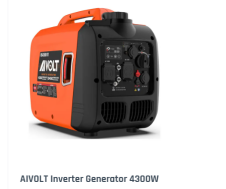Campsites rely on portable inverter generators for power, but improper use can lead to fire, carbon monoxide (CO) poisoning, or electric shock. To keep your trip safe, follow these essential tips—focused on risk prevention, correct operation, and environmental care.
1. Choose a Safe Place to Set Up
Where you place the generator matters most for safety:
- Keep it outdoors, 10+ feet from tents/campsites: Never run it inside tents, RVs, or enclosed shelters—CO (a colorless, odorless gas) builds up quickly and causes poisoning. Position it downwind from your camp to avoid fumes drifting toward sleeping or cooking areas.
- Avoid wet/flammable surfaces: Set the generator on a dry, flat surface (use a plastic mat if the ground is damp) to prevent electric shock. Keep it at least 5 feet from dry grass, leaves, or propane tanks—hot parts of the generator can ignite flammables.
- Follow campground rules: Many campsites have designated generator zones; stick to these to avoid disturbing others and stay compliant with safety regulations.
2. Master Correct Startup & Shutdown Steps
Improper operation during startup/shutdown increases accident risks:
- Check before starting: Inspect oil levels (low oil causes engine damage) and fuel levels—never add fuel while the generator is running (hot parts can ignite spilled gasoline). Tighten the fuel cap to prevent leaks.
- Start with no load: Turn off all connected devices before starting the generator. Once it runs smoothly (after 1–2 minutes), plug in appliances one by one—this avoids overload (which trips safety switches or damages the generator).
- Shut down properly: Unplug all devices first, then turn off the generator. Let it cool for 5–10 minutes before refueling or storing—hot engines can cause burns if touched.
3. Use Safe Power Connections
Faulty wiring or incorrect plugging leads to electric shock:
- Use weatherproof extension cords: Choose 3-prong, heavy-duty extension cords (rated for outdoor use) that match the generator’s wattage (e.g., 12-gauge cords for 1,500+ watts). Avoid frayed or damaged cords—replace them immediately.
- Don’t overload outlets: Check the generator’s maximum wattage (listed in the manual) and never plug in devices that exceed it. For example, a 2,000W generator can’t power a 1,500W AC unit + a 1,000W microwave at the same time.
- Ground the generator: If your model has a grounding terminal, connect it to a metal grounding rod (driven 8+ inches into the ground) with a copper wire—this prevents electric shock if the generator malfunctions.
4. Maintain Safety During Operation
Stay vigilant while the generator runs:
- Never leave it unattended: Turn it off if you leave the campsite (even for a short time) to avoid theft or accidental contact by kids/pets.
- Monitor for issues: Watch for unusual noises (grinding means mechanical problems), smoke, or strange smells (burning wiring is a red flag)—shut down immediately and troubleshoot if you notice these.
- Store fuel safely: Keep extra gasoline in approved, sealed containers (labeled "gasoline")—store them 10+ feet from the generator and away from heat sources.
For a campsite generator that prioritizes safety, the AIVOLT Portable Inverter Generator 4300W is ideal—it has built-in overload protection, low-oil shutdown, and GFCI outlets (preventing shocks), plus a compact design that fits easily in campground zones, making it a reliable and safe choice for outdoor power needs.

